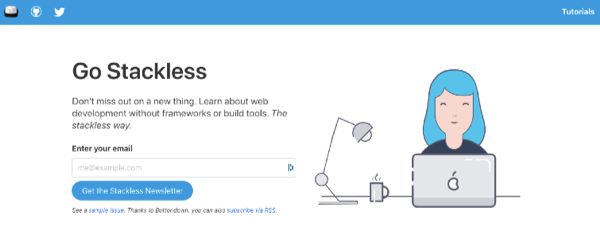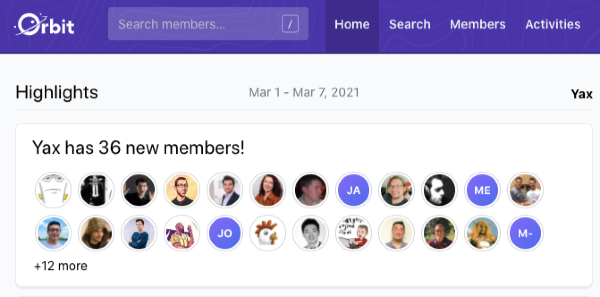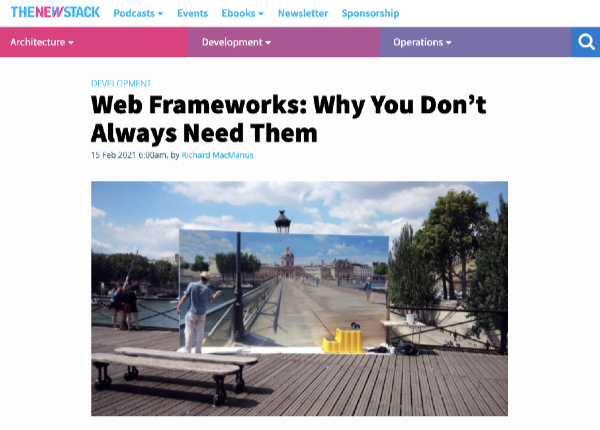Yax.com Daily Worklog
This month, I’ve been working to drive traffic to the Yax website to get feedback from users. In addition to looking for feedback about the user experience, I’m exploring product-market fit.

By the end of the month, Yax had 2575 new visitors. From this traffic, I had 128 visitors subscribe to a Stackless Newsletter I created, with some enthusiastic feedback. Among the visitors, 96 people tried deploying a template with “Try Yax.” I checked GitHub repos and no users had done anything more with their Yax websites than just a test. It seems there is much stronger interest in learning about stackless web development than a website builder product. The interest in the Stackless Newsletter correlates to the main source of the website traffic, an article by tech journalist Richard MacManus on The New Stack magazine titled Web Frameworks: Why You Don’t Always Need Them.
I spent considerable time last month and this month on articles titled Install Ruby on a Mac and Install Rails on a Mac, updating the articles and attempting to improve their search engine ranking. These articles have received steady traffic over several years and I wanted to see if “ad” links on these pages might yield traffic. So far, this is a failed idea: There was no referral traffic from these installation guides to the Stackless Newsletter site (I didn’t try links to Yax).

I’ve done a good job of using a “content marketing” strategy to drive traffic from a market I know well: experienced developers interested in learning new techniques. It’s given me an opportunity to develop a newsletter product, if I wish. However, by staying within the comfort zone of a familiar market, I haven’t made progress in developing product-market fit for Yax as a website builder, except to rule out professional developers as a potential market.
For March, I’ll have to decide whether to continue to develop the audience for the Stackless Newsletter or put new effort into finding a market for Yax.
Here’s the day-by-day report.
February 1, 2021
I used Google Search Console to check if pages are rendering correctly with my yax-markdown tag. Loading JavaScript packages from jspm.dev I got an error, “Page resources couldn’t be loaded.” I replaced jspm.dev with skypack.dev and all resources were loaded, so I updated my sites to use Skypack instead of JSPM. In the future, I’ll undertake a more comprehensive evaluation of Skypack and JSPM.
February 2, 2021
I revised the mac install ruby and mac install rails articles to incorporate recent user feedback. I’ve put a lot of work into the installation guides and I’m striving for accuracy and completeness. I’m hoping that visitors to the installation guides will follow links and check out Yax.com and my newest tutorials.
February 3, 2021
As a result of attention to an article I wrote last month, Out of the Matrix: Early Days of the Web (1991), I was contacted by Richard MacManus, a senior editor at The New Stack (he’s also well known as the founder of ReadWriteWeb), for my comments about the new Rails Hotwire feature. He says he is interested in writing a follow-up article next week about Yax.com and my stackless approach to web development.
February 4, 2021
I looked at Hotwire and watched an interview with David Heinemeier Hansson so I could provide comments to Richard MacManus for his article.
February 5, 2021
I prepared further comments for Richard MacManus’s upcoming article on Hotwire.
February 6, 2021
Today I wanted to understand why other sites get a better ranking in Google search results relative to my mac install rails article. I looked for tools for competitor backlink analysis and tried Moz (the Moz SEO company, not Mozilla). Their Link Intersect tool gave me interesting insights. Entering the URLs for my article plus five other articles that rank highly, I saw a list of over a hundred pages that link to the other sites, ranked by domain authority (how high the domains are likely to rank and thus confer authority). GitHub and Stack Overflow pages rank high but all links on those pages have a “nofollow” attribute (so they are discounted in the Google ranking calculation). Blog posts on sites like Dev.to, HackerNoon, and Hashnode have high domain authority and have “follow” links in the main post (links in comments have a “nofollow” attribute). I’m wondering whether I can publish articles on those sites to increase the page ranking for the mac install rails article.
February 7, 2021
I wrote an answer for Quora, How do I check what version of Ruby is installed? But after thinking about the backlink analysis yesterday, I realize contributing answers to Quora probably doesn’t help much with Google page rank. So then I wrote two articles on the same topic that I’ll try publishing elsewhere.
February 8, 2021
I wrote a draft for an article “Do Not Use the macOS System Ruby.” I’ll revise it and submit it to freeCodecamp to get a backlink to the mac install rails article. I feel I should point out that the article is not pure blogspam. It’s a well-written explanation of an important issue that beginners need to understand. But, yes, my motivation is to get the backlink.
February 9, 2021
Richard MacManus quoted me with links to Yax.com in his article Ruby on Rails Creator Takes on JavaScript Frameworks with Hotwire. I immediately saw a bigger spike in traffic than I’ve seen before. Visitors are trying Yax and deploying templates. Over the next few days I got some helpful user feedback, but not as much as I hoped I would get.
February 10, 2021
I submitted the article Do Not Use the macOS System Ruby for editorial review at freeCodecamp. It was published the next day. Within a few days, it was ranked first for “Use the macOS System Ruby” and ranked sixth for the search “macOS Ruby.” I later published articles on “How to check if Ruby is installed on a Mac” and similar topics on Dev.to, Hackernoon, and Hashnode. After more than two weeks, none of the articles appeared in a Google search. Other than page authority alone, I wonder if Google gives a boost to freeCodecamp because it tends to have higher quality articles? There’s so much guesswork in SEO, I really don’t like it.
February 11, 2021

Judging from the traffic for the previous article, I am expecting a surge in traffic when Richard MacManus runs an article next week focused on Yax and “stackless web development.” Anticipating the increased traffic, I need ways to get longterm engagement with visitors. I decided to offer a newsletter about stackless web development. I set up a mailing list on Buttondown for a Stackless Newsletter and added links on yax.com. And I set up a new website at stackless-community. I also changed my Twitter profile. It’s now: Join stackless.community and build the web without frameworks or build tools. Learn from @danielkehoe founder at yax.com. Author of “Learn Ruby on Rails.” Within 24 hours, I had nine subscribers. This is amazing.
February 12, 2021

I set up Zapier so new subscribers to the newsletter on Buttondown will be added as community members on Orbit, the CRM I use to keep track of communications with users. By the way, Orbit is an incredibly useful tool for anyone building a user community for an open source project or developer services.
February 13, 2021
Perhaps as a result of links from The New Stack articles, a Google search for “yax” shows “Yax.com · Build and Host a Website for Free” in the 8th position in search results. A week ago, a Google search for “yax” just showed a character from the cartoon Zootropolis. It didn’t last, though. Two weeks later, the yax cartoon character was back and yax.com was gone from the “yax” search results.
February 14, 2021

No work today. Went go-kart racing on Valentine’s Day.
February 15, 2021

I want to add the visitors who try Yax as members of the “Yax community” in Orbit, the CRM I’m using to keep track of communications. Orbit has an API, so I added an Orbit API call when a Yax template is deployed to create a “Try Yax” event with a new Orbit member (using the visitor’s GitHub user name). It’s great to see both “Try Yax” visitors and Stackless Newsletter subscribers appearing in the Orbit dashboard. I also want to ask “Try Yax” visitors for feedback. It’s a lot of work to manually email each one (and often their email address is not publicly available on their GitHub profile). So I used the GitHub API to create an a GitHub issue asking for feedback in their “Try Yax” repository. It’s a nice way to automate the request for feedback but unfortunately (after trying it a few weeks), there have been only a handful of visitors responding with feedback.
February 16, 2021

The article Web Frameworks: Why You Don’t Always Need Them was published today on The New Stack magazine website. This article resulted in the greatest number of visitors to the Yax site to date. I looked back at how Richard MacManus discovered my project. On December 31, I emailed Cassidy Williams and suggested she might want to include a link to my article Out of the Matrix: Early Days of the Web (1991) in the Stack Overflow newsletter. She included it, resulting in a lot of traffic and a lot of attention. On January 15, MacManus read the article and quoted from it in a Tweet. I emailed Richard MacManus after seeing his tweet and had a conversation about his history of web development project. Then he noticed a Twitter comment I made about the new Rails Hotwire feature and decided to interview me for an article about Rails Hotwire that was published February 9. He followed the next week with the article focused on Yax and stackless. To me, this indicates that Twitter is a good place to connect to journalists. Judging from the response to MacManus’s articles, mentions in major online tech magazines are a great source of traffic (vastly better than hoping people will follow links in tweets). On February 22 I reviewed Google Analytics for the previous 30 days. Traffic came in two spikes. The first spike was February 9, with 171 visitors, when Richard MacManus mentioned Yax in an article for The New Stack about the new Rails Hotwire feature. The second spike was February 16, with 419 visitors, when Richard MacManus ran the article Web Frameworks: Why You Don’t Always Need Them focusing on Yax and stackless web development. These two articles resulted in over 1200 new visitors out of 2325 visitors in total. In terms of goals, 90 visitors subscribed to the Stackless Newsletter and 56 visitors tried Yax by deploying a template in the first three weeks of February.
February 17, 2021

I got feedback today from Joe Derry Hall, a freelance full stack developer based in Edinburgh, Scotland. He says he’s been, “learning React the past couple of years, but it often feels overly complex – a bit of a sledge hammer to crack a nut, when often I’m creating web apps that need good functionality but aren’t enormously complicated.” He commented, “I’m wondering if the audience for the stackless approach (which I found super interesting) is more like developers and not really ordinary users who want a website, at least until there’s a way to have a really smooth pipeline and some other things to make it easier. It’s been bothering me for a while that I’m using frameworks like React rather than pure standards-based open frameworks and Yax / the stackless way has been very thought-provoking for me, it might be for other developers too.” He feels the Yax site could be overwhelming for ‘ordinary’ computer users (those who know how to use email, Facebook, basic spreadsheets, etc. but need a website). He says, “I tried setting up a Yax site myself and as I’m familiar with GitHub and Netlify etc it was fine – but for ordinary web users I think the process (at least as it is at the moment) could be tough for them. I remember finding GitHub really weird to use when I first discovered it (there’s all your files and folders before you even get to the readme and all sorts of buttons, menu items, etc). And when you’ve deployed with Netlify you come to a deployment log page.”
February 18, 2021
I emailed Bruno Couriol, an editor at InfoQ, to ask if he wanted to write about Yax.com and “stackless” and he wasn’t enthusiastic: “The InfoQ target audience consists largely of senior programmers, most of whom are professionally writing complex applications and have above-average programming skills. The stackless approach is worth mentioning in the frame of the larger context of applying using the right tool for the job and you-aint-gonna-need-it principles to web development. Frameworkless approaches may stand at the left end of the spectrum and stackless even more left to that.” The comment made me think about product market fit. Perhaps an audience of senior programmers is not a good market for Yax or the stackless way because they know how to use complex web development frameworks and they are largely happy with the tools and skills they already have. Are both Joe Derry Hall and Bruno Couriol correct in their assessments? Yax is not good for “ordinary computer users” and also not good for “senior programmers”? Is there some sweet market in the middle? Or no market at all?
February 19, 2021
I looked at the Google SEO ranking for my articles on mac install ruby and mac install rails. On February 5, I added Google structured data for How-To articles. The documentation didn’t answer all my questions so I experimented with some attributes such as “datePublished.” I want to add links on the installation guide sites to generate traffic for Yax and the Stackless Newsletter. I feel I should take advantage of traffic I’m already getting from my previous work. Using Google structured data makes a more eye-catching search result but it doesn’t change the page rank.
February 20, 2021
Thanks to feedback from a “Try Yax” user, I fixed an issue with a non-UTF8 encoding error in the Yax.com deployment function. A user in Norway reported the website description “Få plakatar” blocked deployment to GitHub because the Scandinavian letter å was not recognized. For now, I’ll just replace non-UTF8 characters with a character representing “unknown.”
February 21, 2021

Today I launched the Stackless Newsletter by mailing the first issue to 90 subscribers. My part-time assistant created a “stackless” logo, riffing off my trucker hat motif. A newsletter seems the most effective way to engage with users. And the “stackless” message resonates with web developers. I’m facing a dilemma, though. Writing about stackless web development takes time and I doubt that the experienced web developers who I’m reaching with the “stackless” message are the market for a Yax do-it-yourself website builder. In a sense, it’s a trap for me as it’s a community I know (and where I am known) but my comfort zone and past experience may be getting in the way of finding product-market fit for Yax.
February 22, 2021
I posted to Twitter with excerpts from Stackless Newsletter #1. I got a reply from Avi Flombaum and he suggested a call. Good to hear from him as he’s a respected colleague.
February 23, 2021
My part-time assistant created a slideshow video summarizing the main points in Stackless Newsletter #1 and created a “Stackless” YouTube channel. I posted the video to Twitter, LinkedIn, and the “Ruby on Rails Link” Slack channel. The video didn’t get much response.
February 24, 2021

I had a call with Avi Flombaum, the co-founder of Flatiron School in NYC, one of the first coding bootcamps (and one of the best). Avi reconnected with me after he saw one of my recent tweets. I’ve known Avi for eight years and it was great to catch up with him. He’s been searching for services that would create websites via an API. We talked about the market opportunity for a “websites built via API” service. I’d like to explore the idea and see if it has product-market fit for Yax.
February 25, 2021
I started research for a newsletter article about package managers in programming languages (I’m getting ready to write about the import maps feature in JavaScript). I also made fixes to the pages that contain the video from the YouTube “stackless” channel (to resize properly on phones).
February 26, 2021

Founding editor of Wired magazine, Kevin Kelly, wrote of how, in the creator economy, you only need 1000 true fans to make a living. I read a discussion on Hacker News about the Kevin Kelly essay 1,000 True Fans and a follow-on article from Andreessen Horowitz, 1,000 True Fans? Try 100. It got me thinking about my past experience with my RailsApps project. So I commented, “I had 500 true fans for RailsApps at one point in 2014. They paid $20/month for my Rails tutorials, which supported my open source project. It was wonderful to discover that if you are passionate and deliver your best, often without a thought to monetization, you’ll have fans. ‘100 True Fans’ makes a case for capitalizing on that kind of popularity. But fans can be fickle and creators can lose their passion. Establishing a relationship between fans and a creator isn’t the same as establishing a sustainable business. Now I’d like to build a more sustainable business that reaches more people.” This is the nexus of my concern about developing a fanbase for stackless web development. On the one hand, I feel passionate about exploring and sharing my discoveries about this approach to web development. With RailsApps I had fans right away, and they were willing to pay for tutorials, because a lot of people already wanted to learn Rails. Stackless is too new to have many people who are ready to pay for tutorials. Maybe in time there will be. But I’m not sure it’s going to sustain me financially and it will take time away from developing Yax.com.
February 27, 2021
I continued research for a newsletter article about package managers in programming languages. I posted a question to Reddit (in /r/javascript) to gauge reaction to the article’s premise. I asked, “Is it true to say (with Chrome 89) that the browser now has a built-in package manager and I no longer need ‘npm install’ or Webpack for package management?” Only two people responded, saying “If your goal is to teach beginners, then teach standard tooling. Even if import maps gain mainstream support within a year, it will take at least a decade before bundlers die out. So your beginners will still benefit from having a strong grasp of bundling by the time they start looking for jobs.” I don’t agree, as I think buildless JavaScript makes it easier for beginners to get started. And build tools will become part of automated deployment optimization in the future. But it looks like the world of JavaScript developers (as represented by two voices on Reddit) has no enthusiasm for buildless JavaScript.
February 28, 2021
I published an article for Stackless Newsletter #2, “Praise for packages,” about the importance of package managers in programming languages and how buildless JavaScript will get easier when the newest version of the Chrome web browser ships with import maps next week. Import maps make it possible to specify the exact version of any JavaScript package, loading from a module CDN without a need for Node and NPM. I’m really interested in exploring stackless web development myself and sharing what I discover. But I’m also aware that it’s more of a research project than a business.
Previous: Worklog for November 2020 - [Next: Worklog for March 2021]()